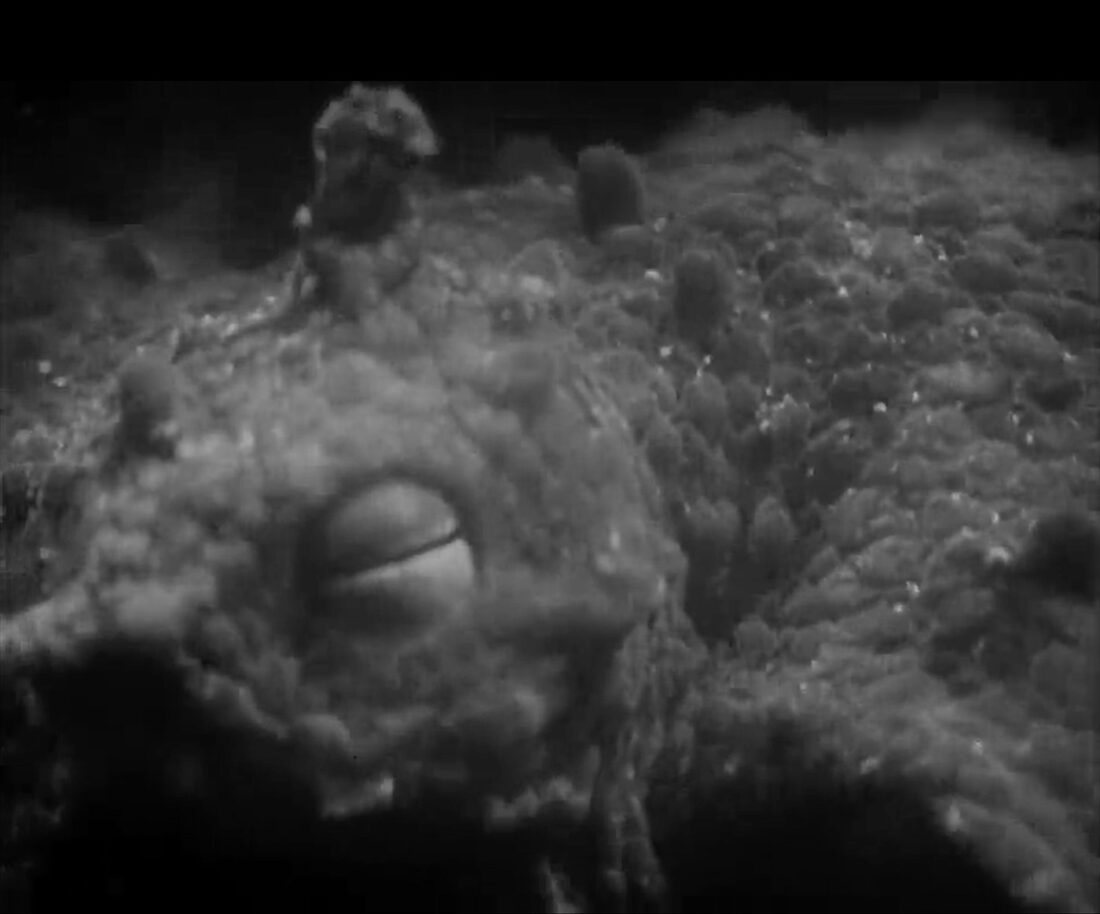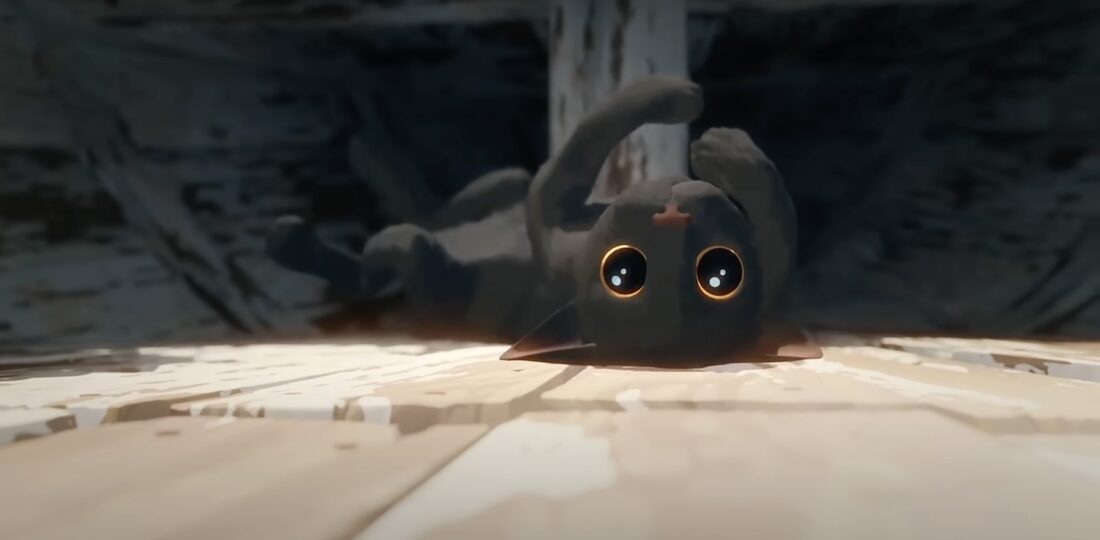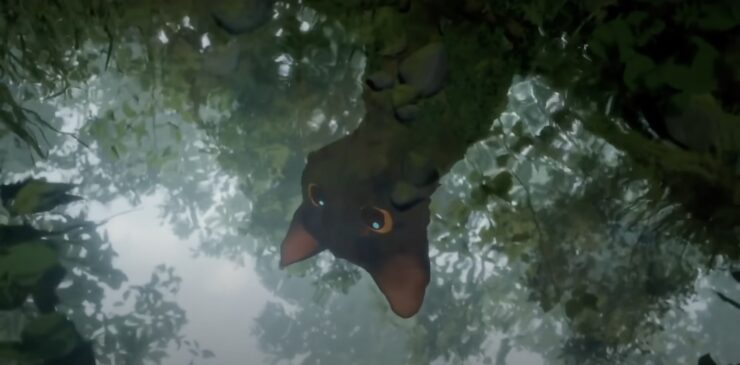The two best films this awards season, both honored at the Golden Globes, both likely to be honored again at the Oscars, ask the same question: What does it mean for a culture to survive catastrophe? Brady Corbet’s The Brutalist tells the story of a Hungarian architect, a victim of Buchenwald, who emigrates to the United States and then constructs a Bauhaus masterpiece, all while navigating the mercurial desires of his degenerate patron. Gints Zilbalodis’ animated feature Flow, the first Latvian film to be nominated in any category, tells the story of a cat who cooperates with a group of animals to survive the rising and falling sea levels, presumably the result of climate change.
Both films consider the purpose of the built environment—and I find it genuinely interesting that both films are rooted in the culture of Central and Eastern Europe, a region with a rich, and to outsiders, often eccentric architectural heritage. But I would like to focus on Flow, and its handful of predecessors. The Brutalist is part of an ever-growing corpus of films to consider the aftermath of genocide. Flow is the rare film to consider animals on their own terms in a post-human world.
As a devout cat-lover, I have been waiting many years for Flow’s hero, a cat who behaves like a cat. But I was just as delighted by the secretary birds and capybaras, who do not cater to the audience any more than an actual secretary bird or capybara would cater to a human they met in the wild. We honor the characters as Zilbalodis honors them, and we mourn for ourselves.
The film suggests a break, though not a complete one, with the usual tropes of animated animals. In animation, particularly animation from 1910s to the 1950s, animals are often anthropomorphized—mice as blackface minstrels, ducks as lunatics, skunks as sexual predators, and later on, lab rats as megalomaniacs and lions as anti-democratic monarchists. Animators had a habit of disregarding animal psychology. There is no dog reason for Goofy to go on a ski vacation or duck reason for Donald to enlist in the U.S. military. And yet there are key instances in which filmmakers respected their characters’ physiognomy—Disney artists carefully studied the musculature of a deer carcass in order to accurately depict Bambi and his kin. In Flow, we see the characters’ external qualities—the affectionate Labradors, the hostile secretary birds, the resourceful capybaras, the gregarious ring-tailed lemurs, and our beloved suspicious, perpetually terrified cat—but despite Zilbalodis’ careful study of his characters’ intra- and inter-species relationships, we can only surmise so much about their inner lives. Their arrangements are analogous to human friendships. More than one viewer may ask if they experience human-like betrayal, guilt, or abandonment, or if they simply appear to experience betrayal, guilt, and abandonment. They are always thinking, but we don’t know exactly what they are thinking.
Unlike Bambi and The Rats of NIMH, Flow does not hate humans. We see the artifacts of the film’s human civilization, but it is up to us to imagine its customs, religion, and language, and to figure out why it has gone extinct. With that said, the artifacts are wonderful and the animals seem to agree. The cat finds refuge in a rustic house in the forest, surrounded by primitive sculptures of felines. A secretary bird experiences a mystical communion atop an enormously tall, vertical islet, bristling with temples. Their relationships would have been impossible without humans, for we are presumably the reason the animals, native to England, continental Africa, Madagascar, and South America, know each other at all. It remains an open question if the animals have any memories of our absent species, and if there’s anything about those memories that excites their love.
Flow is a film of its moment, a work of art that rejects speciesism. We have been trying to make this movie for a century, and I would like to point to a few of the film’s predecessors, one from a documentarian whose fascination with natural life informed his own Communist politics in interwar France, a Disney film from the late 1930s, and finally a three-minute short, produced in Central Europe during the final decade of the Cold War. Each predate our fears of the climate apocalypse, and yet each prepares us for a future without us.
The word “pioneer” should be discouraged in any study of filmmaking. Technologies change rapidly, patent law is confusing, and it’s not always easy to name the originator of any particular innovation. With that said, there are several moments in our history in which filmmakers have utilized new or relatively new technologies or techniques to understand how animals navigate the Anthropocene.
From the 1920s to the 1980s, the French filmmaker Jean Painlevé made several science documentaries, among them studies of marine fauna. In his first commercial work, The Octopus (available on The Criterion Channel), the title character escapes from a house and out to sea. The film is ahead of its time—zoologists have grown increasingly fascinated by the varying personalities of the octopi—and as such we sense the individuality of the hero in their fluid dance, as they triumph over human-made spaces and enter a world that would be inaccessible if not for Painlevé’s water-proof camera box.

Painlevé was a Surrealist, and his aesthetic is most evident in his extreme close-ups. In The Octopus, he fixates on his subject’s eye, an eye with an eyelid so similar to our own, an eye that doesn’t so much reveal as suggest an alternate reality. The pattern of the octopus’s skin serves as a landscape, a miniature planet, as strange as the models of the lunar plain Painlevé would construct in later work.
Off-camera, Painlevé developed a relationship with his subject. He fed them eggs and witnessed their pleasure—evident in the change of their skin—when the egg was fresh, and rage when the egg was rotten. He later said that it was necessary for him to anthropomorphize animals in order understand the world around him. But there were limitations to such an approach, for it was clear that his seahorses and water fleas were privy to a sensory knowledge that humans would never enjoy. Painlevé was a Communist, and in his films, animals are part of a collective order, one in which each strange foreign body is granted individuality.
In the summer of 1937, Disney released The Old Mill, a nine-minute long Silly Symphony—this one set to a song from a Strauss operetta, in which a group of animals, among them an owl, bats, and crickets survive, and in some cases, take shelter from a massive storm. None of the animals have speaking roles, and some are more human-like than others. The bats yawn like small children. The owl remains proud and solitary. The crickets are lined up in formation, but one that seems natural to their cricket-ness; we think of them as an organized orchestral arrangement, but they don’t. At the time, the film was most notable for its use of the multiplane camera, an invention that allowed Disney to mimic the depth of field and camera movement of live-action film, and which would be employed again, later that year, in Snow White and the Seven Dwarfs. Rather than placed flatly against a two-dimensional plane, the animals are effectively stars in a deep space normally reserved for human actors.
Like Flow, the film does not hate the species that created it. Humans have created a building, which they have since abandoned, that actually helps the animals, saves them from a natural disaster that would have otherwise killed them. The rustic old mill is a natural, fitting part of the landscape, not debris that intrudes upon the animals’ lives.
In 1980, Pannonia Film in Hungary released The Fly, a three-minute short told from the perspective of a fly who finds themself inside a proper home on an autumn day. The film employs background animation, a time-annihilating technique whereby the entire frame is redrawn from one frame to the next. (In classic Hollywood animation, the background remains static, and only individual characters, placed in the foreground, move; thus animators are charged with drawing only a small part of the picture from one frame to the next.) The Fly required more than 3000 heavily detailed pictures, each of which mimic a fly’s wide-angle vision. A special effect involving a poked hole recreated the glimmer of a window. The soundtrack, the incessant, spare buzz of the fly—borrowed from a phrase on the Pink Floyd album Ummagumma—is chilling. It took years to make, and no one in the studio believed the young director Ferenc Rofusz and his small team would finish it, nor that it would win an Academy Award.
Rofusz’s film offers the perspective of an uncharismatic animal, granting it no human-like characteristics other than an instinct to live. At the end, an unseen human traps the fly in a windowsill. He then impales it on a pin before placing it within an insect collection box. He murders a sentient being, not just out of annoyance, as one would assume, but out of curiosity. (Rofusz originally planned an alternate ending in which the human trips and falls and the fly escapes the house.)
There are several interpretations. North American and West European critics (as well as several of my former students), informed by stereotypes of dissident artists, are often tempted to assume an anti-authoritarian message in animated films from Central and Eastern Europe. I was guilty of the same assumptions when I started studying work from this region and era. I have grown more inclined to think of The Fly as part of a tradition rooted in alienation, a means of decentering the field of human senses. As animal-rights activists, particularly in Europe, are considering the pain suffered by insects, I take the film even more literally, simply as a drama describing the most terrible stakes inherent in short lives lived everyday in our households, in just about every home on each continent on Earth.

In his acceptance speech at the Golden Globes, Zilbalodis noted that he worked with a small team in a small country, and that he had to learn for the first time how to collaborate and work with others, like the cat in Flow. Unlike The Fly, and Painlevé’s documentaries, Flow does not alienate human viewers, and unlike Disney, Zilbalodis doesn’t pander to them. Zilbalodis may see the cat as a mirror of himself. But the cat is impressive even if he isn’t the subject of our identification. He is, quite plainly, a remarkable cat.
Human laborers can disappear in live-action film—in Hollywood movies you do not think about the foley artists responsible for the sound of footsteps or the cameraman who set up a well-composed medium shot. Animated films, however, forefront workers, and all but require audiences to imagine the process by which they are made. Who designed and invented that multiplane camera? Who was that small team of artists who spent an average of one year on a single minute of such a heavily detailed film? Bow your head, but bow it slightly. These films respect animals, but also our talent to realize a world beyond ourselves.











I loved Flow and agree with much of what was said here! I did think it was implied that the house was once inhabited by the cat’s human companion, as we see drawings and the cat seems comfortable there.
Yes, the deepest mystery and tragedy of the film, to me, was what had happened to the cat’s human. I would expect the cat misses the bigfriend who used to bring food, and would be sad about losing the home they shared.
I sort of had the impression that the humans had left the world by way of the same kind of portal that the bird vanishes into near the end. Personally I would not depart for some dimension of transcendence if I couldn’t take my cats with me.
If this is your audition to write the essay for the Criterion release of Flow, I’d say you nailed it. Amazing work, thank you for writing this! I’m definitely going to check out those short films you mentioned.
Flow is fundamentally flawed in the manner of most passion projects but I did not regret watching it. It was visually stunning and often entertaining. In the end it really could have used a few rounds of polishing to make the characters and story beats more compelling and coherent. And how in the world you could make a capybara into a forgettable peripheral character is beyond me. What a waste of one of the most charismatic animals on earth.